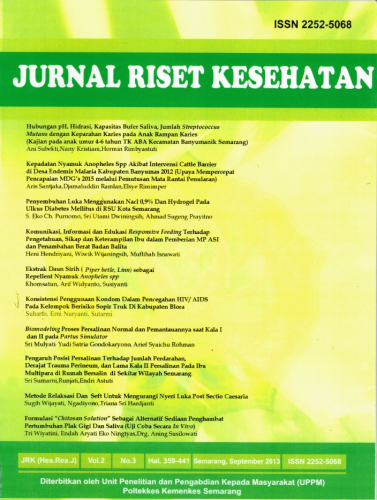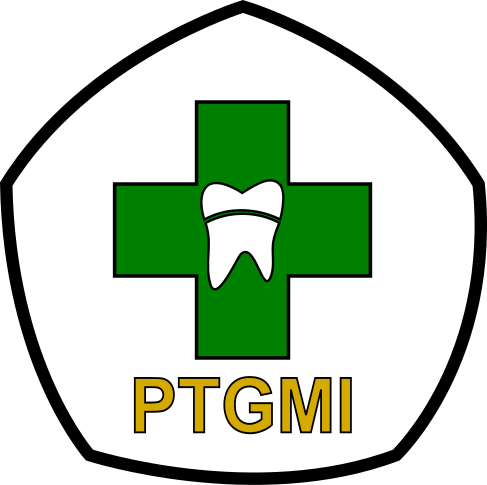DYSPHAGIA TOWARDS NUTRIENT INTAKE AND MALNUTRITION CASE IN STROKE PATIENTS: LITERATURE REVIEW
Abstract
Dysphagia is one of the most important clinical manifestations of stroke and can pose a greater risk of malnutrition for patients during and after hospitalization. The purpose of this research is to review the literature about dysphagia on nutrient intake and malnutrition case in stroke patients. Type of the research is literature review which consist of journals cited the incidence of stroke patients suffered Dysphagia from 2015–2020 year of national and international publication. The result of dysphagia people can only consumed 10–33% of nutrient intake during 2 weeks and 3 months at home. This condition is insufficient for the energy and nutritional needs of the patient and can effect malnutrition case due to dysphagia which is 6-78%. The enteral formula can be obtained to reach energy and nutrients by focusing to the stroke patient treatment. Dysphagia experienced by stroke patient will affect nutrient intake and the malnutrition case. The suggestion of this paper is pointed to the health workers and the family of dysphagia people to concern energy and nutrients needs of the patient regularly.
Keywords
Full Text:
PDFReferences
Adam C. Lieber, Estee Hong, David Putrino, Dominic A. Nistal, Jonathan S.Pan, C. P. K. (2018). Nutrition, Energy Expenditure, Dysphagia, and Self-Efficacy in Stroke Rehabilitation : A Review of the Literature. Brain Sciences, 8(218), 1–12. https://doi.org/10.3390/brainsci8120218
Aditya Purnama Meidarahman, Fakhrurrazy, T. (2019). Hubungan Status Nutrisi Saat Masuk Rumah Sakit dengan Outcome pada Pasien Stroke Iskemik. Homeostasis, 2(1), 107–112.
Aliasghari, F., Izadi, A., Khalili, M., Farhoudi, M., Ahmadiyan, S., & Deljavan, R. (2018). Impact of Premorbid Malnutrition and Dysphagia on Ischemic Stroke Outcome in Elderly Patients : A Community-Based Study Impact of Premorbid Malnutrition and Dysphagia on Ischemic Stroke Outcome in Elderly Patients : A Community-Based Study. Journal of the American College of Nutrition, 0(0), 1–9. https://doi.org/10.1080/07315724.2018.1510348
Arif, M. (2017). Hubungan pelaksanaan screening test menelan dengan kejadian disfagia pada pasien baru yang menderita stroke akut. Jurnal Kesehatan Perintis, 4, 61–67.
Buoite, A., Gaio, M., Furlanis, G., Douglas, P., Naccarato, M., & Manganotti, P. (2019). Fluid and energy intake in stroke patients during acute hospitalization in a stroke unit Fluid and energy intake in stroke patients during acute hospitalization in a stroke unit. Journal of Clinical Neuroscience, (April 2020). https://doi.org/10.1016/j.jocn.2019.01.016
Chen, N., Li, Y., Fang, J., Lu, Q., & He, L. (2019). Risk factors for malnutrition in stroke patients: A meta-analysis. Clinical Nutrition, 38(1), 127–135. https://doi.org/10.1016/j.clnu.2017.12.014
Cristina Dessuy Vieira, D., Cristina Callegaro, C., Schmidt Pasqualoto, A., & Beatriz Bento Franz, L. (2018). Changes in Food Consistency Improve Quality of Life Related to Swallowing in Post-stroke Patients at Risk of Dysphagia Specialization in physical-motor rehabilitation, Postgraduate Program in Human Communication Issues. Journal of Food and Nutrition Research, 6(1), 62–68. https://doi.org/10.12691/jfnr-6-1-10
Giovanni Morone, Marco Iosa, Teresa Paolucci, Luca Muzziolli, S. P. (2019). Relationship Between Body Mass Index and Rehabilitation Outcomes in Subacute Stroke With Dysphagia. American Journal of Physical Medicine & Rehabilitation, 98(7), 608–612. https://doi.org/10.1097/PHM.0000000000001159
Gomes, F., Emery, P. W., & Weekes, C. E. (2016). Risk of Malnutrition Is an Independent Predictor of Mortality, Length of Hospital Stay, and Hospitalization Costs in Stroke Patients. Journal of Stroke and Cerebrovascular Diseases, 25(4), 799–806. https://doi.org/10.1016/j.jstrokecerebrovasdis.2015.12.017
Gowun Kim, Sora Baek, Hee-won Park, Eun Kyoung Kang, G. L. (2018). Effect of Nasogastric Tube on Aspiration Risk : Results from 147 Patients with Dysphagia and Literature Review. Dysphagia, 33(6), 731–738. https://doi.org/10.1007/s00455-018-9894-7
Hagnyonowati, M. R. A. (2017). Penatalaksanaan Gizi pada Pasien Stroke dengan Disfagia. Medica Hospitalia : Journal of Clinical Medicine, 3(3), 204–206. https://doi.org/10.36408/mhjcm.v3i3.236
Holdoway, A., & Smith, A. (2010). Meeting Nutritional Need and Managing Patients with Dysphagia. Nutricia, 52–59.
Hsieh, D., Hung, J., Chang, K., Huang, Y., Lee, T., & Chen, H. (2017). Malnutrition in Acute Stroke Patients Stratified by Stroke Severity- A Hospital Based Study. Acta Neurologica Taiwanica, 26(3), 120–127.
Isti Suryani, Nitta Isdiany, G. A. D. K. (2018). Dietetik Penyakit Tidak Menular (Tahun 2018; Heny Kurniawati, ed.). Jakarta: Kementrian Kesehatan Republik Indonesia.
Juan, W., Zhen, H., Yan-ying, F., Hui-xian, Y., Tao, Z., Pei-fen, G., & Jian-tian, H. (2019). Comparative Study of Two Tube Feeding Methods in Patients with Dysphagia After Stroke : A Randomized Controlled Trial. Journal of Stroke and Cerebrovascular Diseases, 1–9. https://doi.org/10.1016/j.jstrokecerebrovasdis.2019.104602
Karunia, E. (2016). Hubungan antara dukungan keluarga dengan kemandirian. Jurnal Berkala Epidmeiologi, 4, 213–224. https://doi.org/10.20473/jbe.v4i2.2016.213
Kasim, V. N., Pateda, S. M., Hadju, V., & Jafar, N. (2017). Suplementasi ekstrak albumin ikan gabus terhadap status gizi dan. Jurnal Gizi Klinik Indonesia, 13(3), 91–98.
Kim, D., & Lee, K. (2019). Nutrition Care Management Practices for In-Patients with Dysphagia in Korean Clinical Settings. Clinical Nutrition Research, 8(4), 272–283.
Kokura, Y., & Wakabayashi, H. (2018). Nutritional Intake is Associated with Activities of Daily Living and Complications in Older Inpatients with Stroke. Epidemiology, Clinical Practice and Health, 25, 1–6. https://doi.org/10.1111/ggi.13467
Leem, M., Moon, H. I., & Kim, K. H. (2018). Differences in Nutrition and Hydration Status Related to Swallowing Function and Age in Acute Stroke Patients. Journal of Food and Nutrition Research, 6(12), 719–724. https://doi.org/10.12691/jfnr-6-12-1
Linh, N. T., Hien, B. T., Trung, N. D., & Huong, N. M. (2018). Nutritional Status , Dysphagia and Dietary Of Elderly Stroke Patients At Vietnam Friendship Hospital. Journal of Medical Reseacrh, 3(7), 60–67.
Lisda Amalia, Fadila Arsanti, G. M. (2019). Hubungan Luaran Subjective Global Assessment ( SGA ) Dengan Derajat Keparahan Stroke. Neurona, 36, 170–175.
Morris, H. (2018). Adapting mealtimes to residents with dysphagia. MA Healthcare Ltd, 20(12), 2016–2019. Retrieved from magaonlinelibrary.com
Mozzanica, F., Rosa, S., Scarponi, L., & Schindler, A. (2018). Prevalence of dysphagia , malnutrition and dehydration at admission in a Stroke Unit. Otorinolaringologia, 68(1), 23–27. https://doi.org/10.23736/S0392-6621.17.02137-3
Niken Puruhita, Rani Armeidani, A. K. (2016). Medica Hospitalia. Medica Hospitalia : Journal of Clinical Medicine, 3(3), 207–212.
Nishiyama, A., Wakabayashi, H., Nishioka, S., Nagano, A., & Momosaki, R. (2019). Energy intake at admission for improving activities of daily living and nutritional status among convalescent stroke patients. Neurologia Medico-Chirurgica, 59(8), 313–320. https://doi.org/10.2176/nmc.oa.2019-0002
Ojo, O., & Brooke, J. (2016). The Use of Enteral Nutrition in the Management of Stroke. Nutrients, 8, 1–6. https://doi.org/10.3390/nu8120827
Ongun, N. (2019). Nutritional follow-up in patients with ischemic stroke : With a screening test or with blood parameters ? Annals of Medical Research, 26(9), 1902–1906. https://doi.org/10.5455/annalsmedres.2019.06.313
Ortega Barrio, M. Á., Valiñas Sieiro, F., Almarza Fernández, M. T., Bravo Santamaría, S., & Moreno Maestro, R. (2019). Effect of stroke on nutritional status and its relationship with dysphagia.
Revista Científica de La Sociedad de Enfermería Neurológica (English Ed.), (xx). https://doi.org/10.1016/j.sedeng.2019.04.003
Shinta Nishioka, Hidetaka Wakabayashi, Emi Nishioka, Tomomi
Yoshida, Natsumi Mori, R. W. (2016). Nutritional Improvement Correlates with Recovery of Activities of Daily Living among Malnourished Elderly Stroke Patients in the Convalescent Stage. Journal of the Academy of Nutrition and Dietetics, 116(5), 837–843. https://doi.org/10.1016/j.jand.2015.09.014
Shinta Nishioka, Kazumi Yamasaki, Kenji Ogawa, Kana Oishi, Yoko Yano, Yuka Okazaki, Ryusei Nakashima, M. K. (2019). Impact of nutritional status , muscle mass and oral status on recovery of full oral intake among stroke patients receiving enteral nutrition : A retrospective cohort study. Nutrition & Dietetics, (December 2018), 1–11. https://doi.org/10.1111/1747-0080.12579
Sporns, P. B., Muhle, P., & Hanning, U. (2017). Atrophy of Swallowing Muscles Is Associated With Severity of Dysphagia and Age in Patients With Acute Stroke Atrophy of Swallowing Muscles Is Associated With Severity of Dysphagia and Age in Patients With Acute Stroke. Journal of the American Medical Directors Association, (March). https://doi.org/10.1016/j.jamda.2017.02.002
Untari, D., Kariasa, I., & Adam, M. (2019). Efektivitas Perawatan Mulut Menggunakan Madu Terhadap Risiko Pneumonia Aspirasi Pada Pasien Stroke Yang Mengalami Penurunan Kesadaran Dan Disfagia. Journal Educational of Nursing, 2(1), 26–38.
Zhang, J., Zhao, X., Wang, A., Zhou, Y., Yang, B., Wei, N., … Wang, Y. (2015). Emerging malnutrition during hospitalisation independently predicts poor 3-month outcomes after acute stroke: Data from a Chinese cohort. Asia Pacific Journal of Clinical Nutrition, 24(3), 379–386. https://doi.org/10.6133/apjcn.2015.24.3.13
DOI: https://doi.org/10.31983/jrk.v9i2.6072
Article Metrics
Refbacks
- There are currently no refbacks.
Copyright (c) 2020 Jurnal Riset Kesehatan



















































